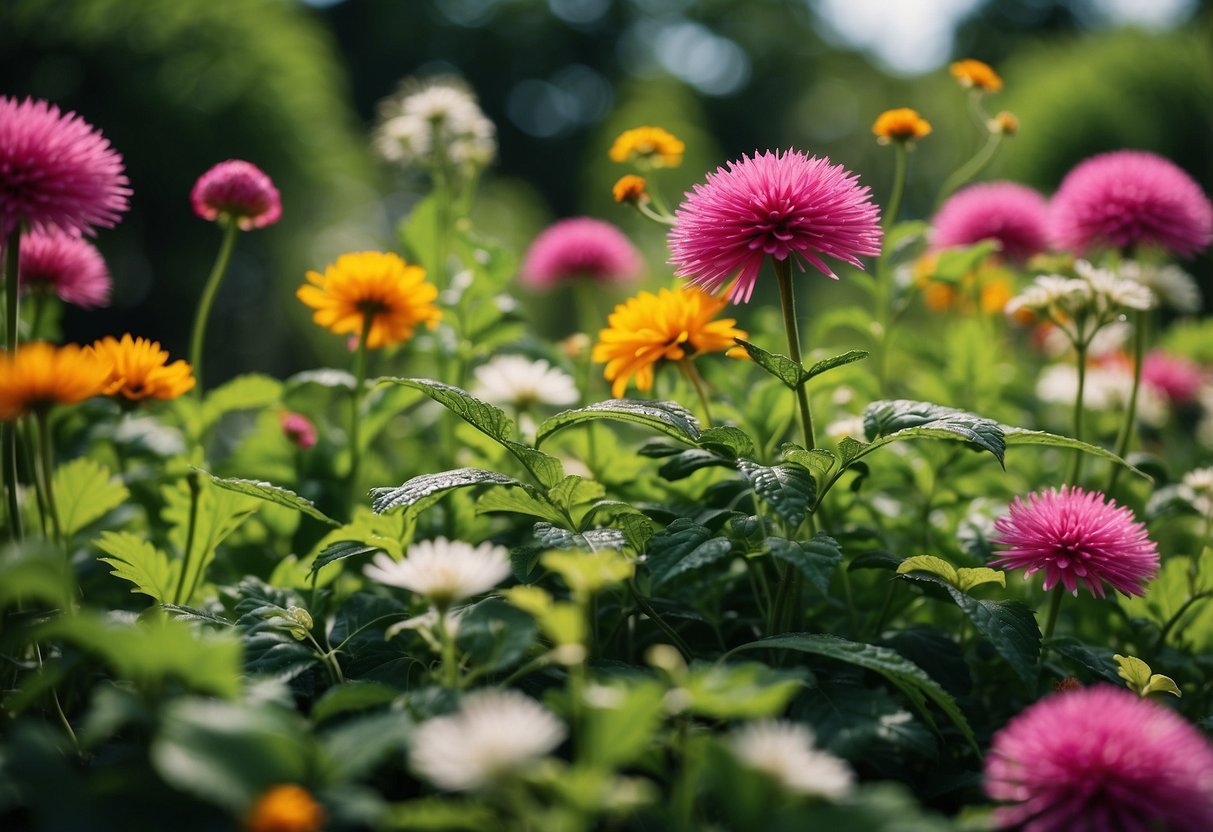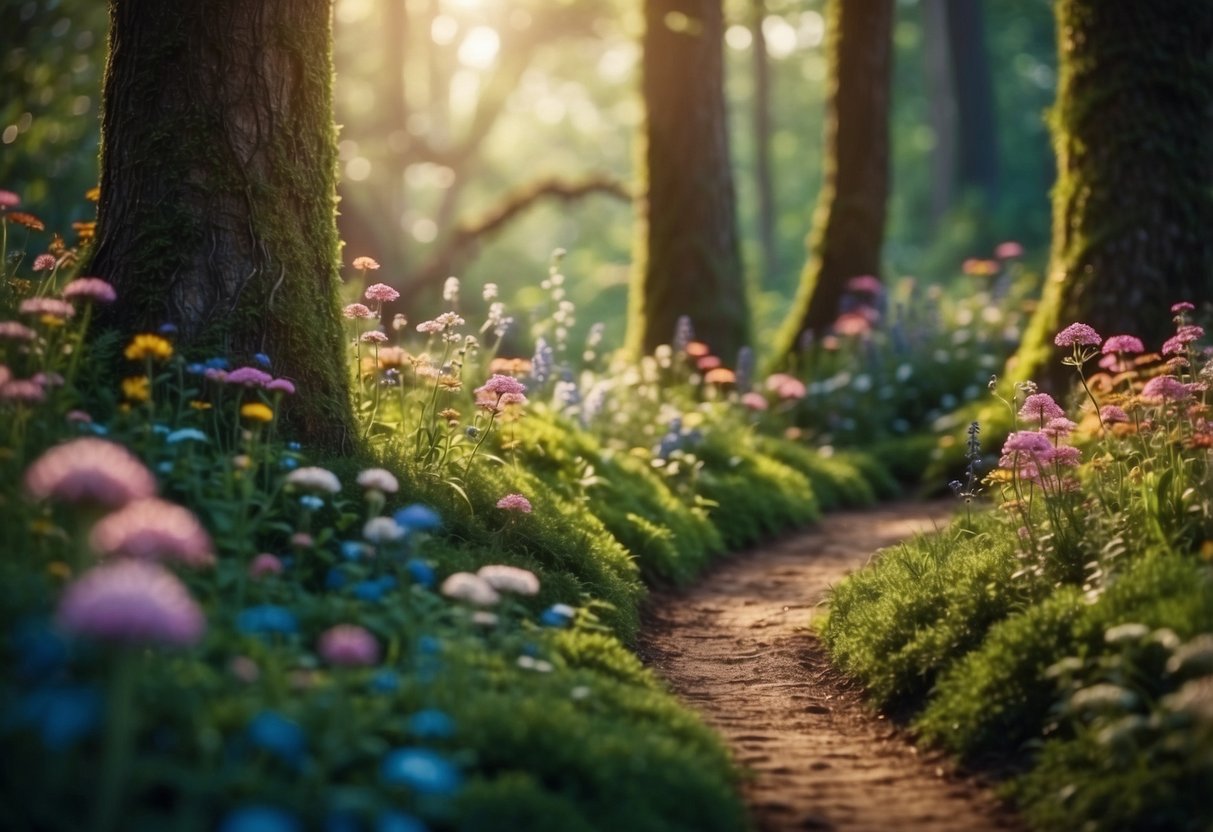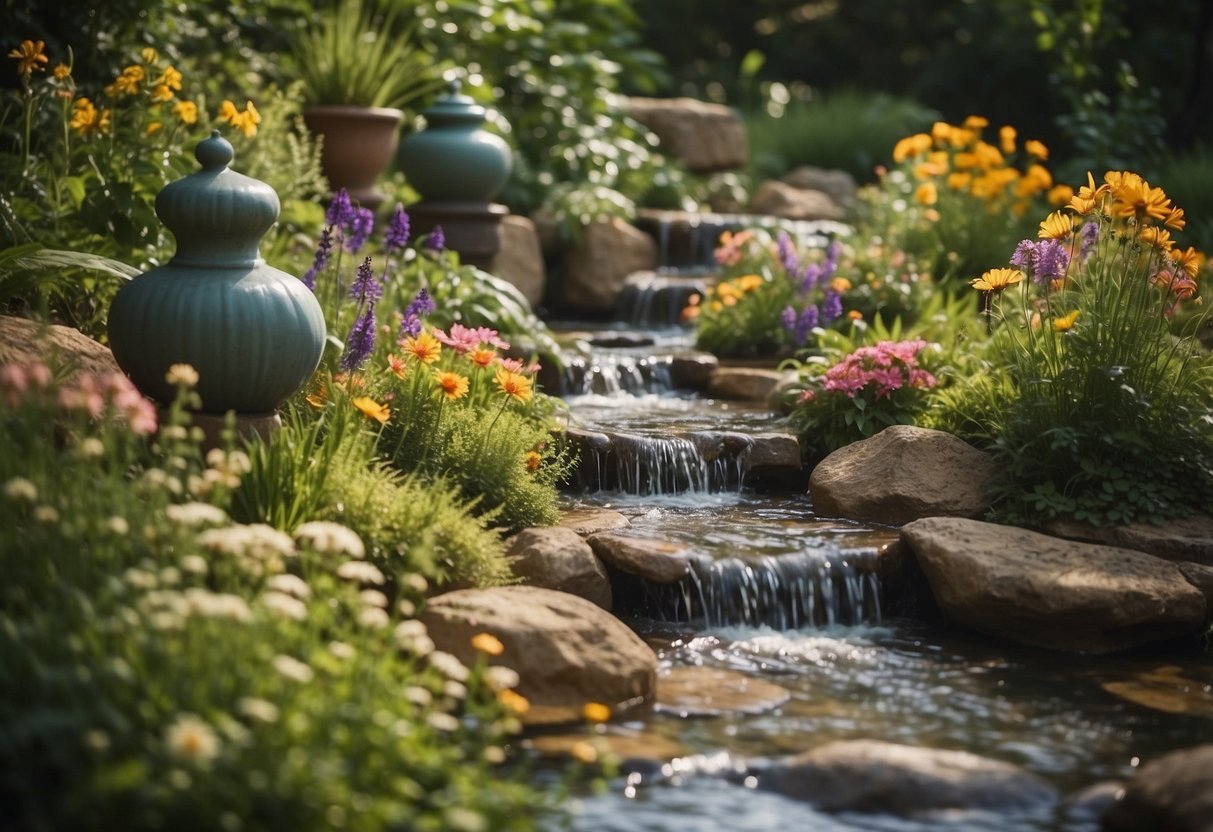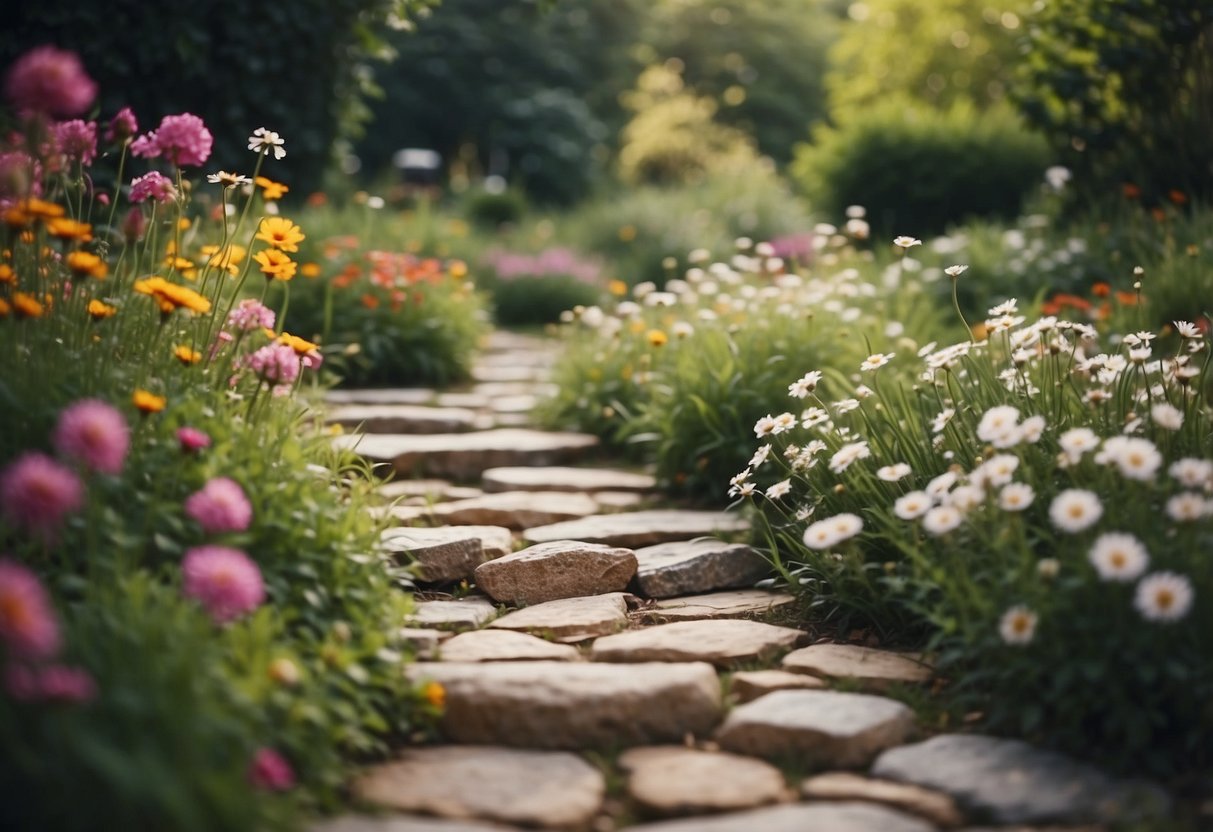Wild Garden Ideas: Creative Tips to Transform Your Outdoor Space
Transforming your garden into a wild oasis can bring a sense of nature right to your doorstep. Whether your goal is to attract wildlife, add vibrant colors, or create a serene retreat, there are countless ways to achieve a beautiful and lively green space. What makes this endeavor truly rewarding is the joy of seeing your garden come alive with birds, bees, and butterflies.

You don’t need to be an expert gardener to start a wild garden. With a bit of planning and creativity, anyone can design a space that thrives with native plants and provides a haven for local wildlife. Plus, it’s a wonderful way to make a positive impact on the environment right in your own backyard.
1) Fairy Tale Footpaths

Create magical pathways with stones leading through your garden. Use flat, smooth stones that are easy to walk on.
Line the path with small ferns, moss, or creeping thyme for a soft, lush feel. For a more whimsical touch, add tiny fairy statues or mushroom decorations.
Incorporate colorful vining plants like morning glory or sweet peas to wrap around any trellises along the path. Keep the pathway inviting and enchanting for both kids and adults alike.
2) Butterfly Haven

Turning your garden into a butterfly haven is a wonderful way to support local wildlife. Start by planting nectar-rich flowers like milkweed and coneflower to attract butterflies.
Create a sheltered space. Use shrubs and plants to protect butterflies from strong winds and predators. Adding a few flat stones can give them a sunny spot to rest and warm up.
Avoid using pesticides, as they harm butterflies and their larvae. Instead, opt for natural pest control methods. Learn more about creating a vibrant butterfly garden to enjoy the sight of these graceful insects all summer long.
3) Secret Zen Corner

Create a calming Secret Zen Corner with a small water feature surrounded by pebbles. The gentle sound of water can help you relax.
Add ferns and hostas to mimic a forest floor. These plants are easy to grow and maintain in shaded areas.
Consider placing a small stone pagoda or lantern to enhance the tranquil atmosphere of your Zen garden.
4) Magical Mushroom Ring

A magical mushroom ring can transform your garden into a whimsical wonderland. Imagine stepping outside and feeling like you’ve entered a fairy tale.
To create your own, consider using ceramic mushrooms painted in vibrant colors. They add a pop of color and charm to your space.
Fairy ring mushrooms are another enchanting option. They’re perfect for crafting a mystical atmosphere that feels straight out of a storybook. Check out some captivating fairy ring ideas for inspiration.
5) Wildflower Wonderland

Create a Wildflower Wonderland by filling your garden with vibrant and diverse flowers. Choose a mix of purple, blue, red, yellow, and orange blooms like tickseed, black-eyed Susan, and verbena.
Include wild grasses that attract beneficial pollinators. Your garden will be colorful and buzzing with life. Select native species for better adaptation and growth. Make sure to pick a sunny spot with well-draining soil.
Prepare the soil by loosening it and removing weeds. Scatter seeds evenly and lightly cover them with soil. This setup will ensure a thriving Wildflower Wonderland.
6) Whimsical Water Feature

A whimsical water feature can add charm and life to your wild garden. Imagine a small, sparkling fountain or a playful goblin in a barrel fountain that reflects your personality.
A simple birdbath or a pond with colorful fish also attracts wildlife and creates a peaceful ambiance. Adding a winding stream can make your garden look more dynamic and enchanting.
7) Meandering Stone Paths

Meandering stone paths can add charm to your wild garden. Instead of straight lines, let them twist and turn. This creates a natural look that matches the beauty of your plants.
Use different types of stones to give texture to your path. You can combine large flagstones with small pebbles to keep it interesting.
Think about adding stepping stones surrounded by gravel or mulch. This not only looks pretty but helps with drainage. Your garden will have a unique, rustic feel that invites exploration.
For more ideas, visit garden path ideas.
8) Charming Chickens Roaming

Chickens add a delightful charm to your garden. Their colorful feathers and quirky personalities can bring life to any yard. Watching them scratch and peck can be quite soothing.
If you have enough space, let your chickens roam freely. They will help control pests and fertilize your garden naturally.
Creating a chicken-friendly garden is key. Plant some of their favorite herbs and vegetables to keep them happy and occupied. This way, they are less likely to damage your main garden. For more ideas, check out Tilly’s Nest.
9) Rustic Garden Swing

Adding a garden swing brings charm and relaxation to your outdoor space. Choose a rustic wooden design to match a nature-themed backyard.
Position the swing under a large tree for shade and comfort. Enhance the cozy vibe with some cushions or throw blankets.
For a unique touch, consider using repurposed materials like an old pallet or vintage bench to create your swing. Find inspiration from these garden swing ideas.
10) Birdsong Symphony

Creating a birdsong symphony in your garden can bring peace and joy. Place bird tables to attract various species with their melodies. Imagine waking up to the sounds of chirping and singing.
Add a bee house or birdhouse to give them shelter. Wildlife needs safe spaces to nest and rest. Enjoy the magic of birdsong daily.
Mix native plants like tickseed and black-eyed Susan to attract even more birds. Don’t forget to add water features like a small pond or birdbath. This invites birds to bathe and drink, enhancing your natural haven.
Benefits of a Wild Garden

A wild garden offers several benefits, enhancing both the environment and personal enjoyment. Native plants, biodiversity, and low maintenance create a harmonious space for wildlife and humans alike.
Environmental Benefits
Creating a wild garden helps promote biodiversity. By using native plants, you provide food and shelter for local wildlife, including pollinators like bees and butterflies. This, in turn, supports the broader ecosystem.
The presence of various organisms, from fungi to small mammals like field mice and voles, helps improve soil health. The natural breakdown of leaf litter by these creatures enriches the soil with organic matter. This process improves soil structure and water retention.
Additionally, wild gardens require less irrigation and chemical inputs compared to traditional gardens. Native plants are adapted to local conditions and tend to be more drought-resistant. Reducing the use of pesticides and fertilizers helps prevent water pollution and supports the health of nearby water sources.
Aesthetic and Personal Enjoyment
A wild garden brings a unique, natural beauty to your backyard. Unlike the neat lines of traditional gardens, wild gardens have an informal, relaxed look that many find appealing. The variety of plant species results in a colorful and ever-changing landscape throughout the seasons.
Creating such a space can also be a rewarding and educational experience. Watching the interplay between plants and wildlife allows you to observe nature up close. It can be very satisfying to see birds, butterflies, and other creatures thriving in your garden.
Wild gardens are also low maintenance. Once established, they require minimal care, freeing up time for you to enjoy your garden rather than constantly working in it. This makes it an ideal choice for busy individuals who still want a beautiful, vibrant outdoor space without the constant upkeep.
Planning Your Wild Garden

Creating a wild garden involves careful selection of native plants and thoughtful design of pathways. This kind of garden helps preserve local wildlife and provides a natural, beautiful space.
Choosing the Right Plants
When selecting plants, focus on native species that support local wildlife. Native plants are adapted to your area’s soil and climate, making them easier to grow and maintain.
Consider including wildflowers like cornflowers, which come in various colors such as blue, pink, and white. These flowers are easy to manage and reseed themselves, adding continuous beauty to your garden.
Plants that attract bees, butterflies, and birds are essential. For example, planting milkweed supports monarch butterflies. A mix of flowers, shrubs, and grasses will offer food and shelter to different kinds of wildlife.
It’s a good idea to group plants that have similar water and sunlight needs. This will help them thrive and reduce the amount of work you need to do.
Designing Natural Pathways
Natural pathways offer both function and aesthetics in a wild garden. They help you navigate through the garden and create a sense of exploration.
Use materials like gravel, wood chips, or stepping stones to create your paths. These materials blend well with the natural environment and are easy to maintain.
Curved paths often look more natural than straight ones. They can also make small gardens feel larger by taking the walker on a winding, scenic route.
Incorporate elements like logs or rocks along the edges to enhance the natural look. These can double as habitats for small creatures like insects and small mammals.
Make sure the paths are wide enough for comfortable walking. A good width is typically around 2-3 feet. This makes it easy for you and your guests to enjoy the garden.
Maintaining a Wild Garden

Taking care of a wild garden involves ensuring proper watering and minimal pruning. These steps help keep the garden thriving and looking beautiful.
Watering and Irrigation Tips
Watering a wild garden properly is key to its health. Most wildflowers need about 1 inch of water per week. Use a rain gauge to measure this. Water deeply once or twice a week, rather than daily, to encourage deep root growth.
Early morning is the best time to water, reducing evaporation and giving plants a chance to dry off before evening. This helps prevent diseases. Soaker hoses or drip irrigation systems can be helpful.
Mulching with organic materials like straw or wood chips can help retain moisture. This reduces the frequency of watering and keeps the soil cool.
Pruning and Deadheading
Pruning helps keep your garden tidy and healthy. Remove any dead or diseased growth to prevent the spread of disease. Trim overgrown plants to maintain their shape and to encourage new blooms.
Deadheading involves cutting off spent flowers. This neatens up the garden and often encourages more blooms. Use sharp scissors or pruning shears to make clean cuts.
Timing is important. For most wildflowers, you should prune in late winter or early spring before new growth starts. Avoid heavy pruning in late summer or fall, as this can stress plants before winter. Regular, light pruning helps maintain a natural look.







